Specialties in Son La must be tried once when traveling and bought as gifts - Son La is a rich Northwest land,not only impressing with its natural scenery but also attracting visitors with its bold specialties. national identity. Let's explore and choose delicious Son La specialties with 63Stravel as meaningful gifts for friends and relatives!
Specialties in Son La must be tried once when traveling and bought as gifts
Suggesting some Son La specialties that you must try once when traveling and buy as gifts for relatives.
Pa Pinh Top
Specialties in Son La must be tried once when traveling and bought as gifts - Son La is a Northwest region that is not only famous for its majestic natural scenery but also captivates tourists with its unique and diverse cuisine. form. The ethnic dishes here bear the cultural imprint and love of nature of the local people. Among them,Pa Pinh Top,the grilled stream fish dish of the Thai people,has become a culinary symbol not to be missed when visiting this land.
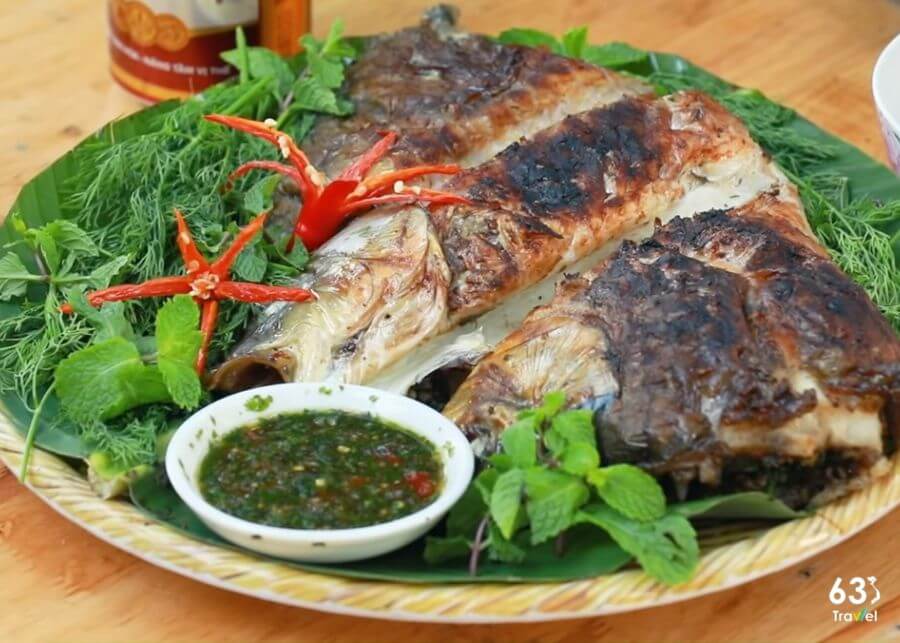
Pa Pinh Top - Son La specialty you should try
Pa Pinh Top is elaborately prepared with fresh stream fish carefully marinated with mac khen,lemongrass,ginger,and wild chili,then stuffed with spices,turned over and grilled on a charcoal stove. Grilled fish meat is sweet and chewy,imbued with the flavor of the mountains and forests,combined with Cham Xo and sticky sticky rice to create a harmonious,unforgettable flavor. The dish is not only a specialty but also the pride of Son La people,very suitable to buy as a gift,bringing Northwest flavors to relatives and friends.
Nam Pia
Nam Pia is one of Son La's famous specialties,especially popular in traditional Thai cuisine in Moc Chau. The name "Nam Pia" comes from the Thai language,in which "nam" means soup,and "pia" refers to the viscous fluid from the small intestine of herbivores,or feces.
The main ingredients to prepare this dish include internal organs of cows,goats or horses such as liver,lungs,heart,combined with a unique "pia". All are cooked with typical spices such as mac hen,lemongrass,chili and Chinese coriander,creating an unforgettable flavor.
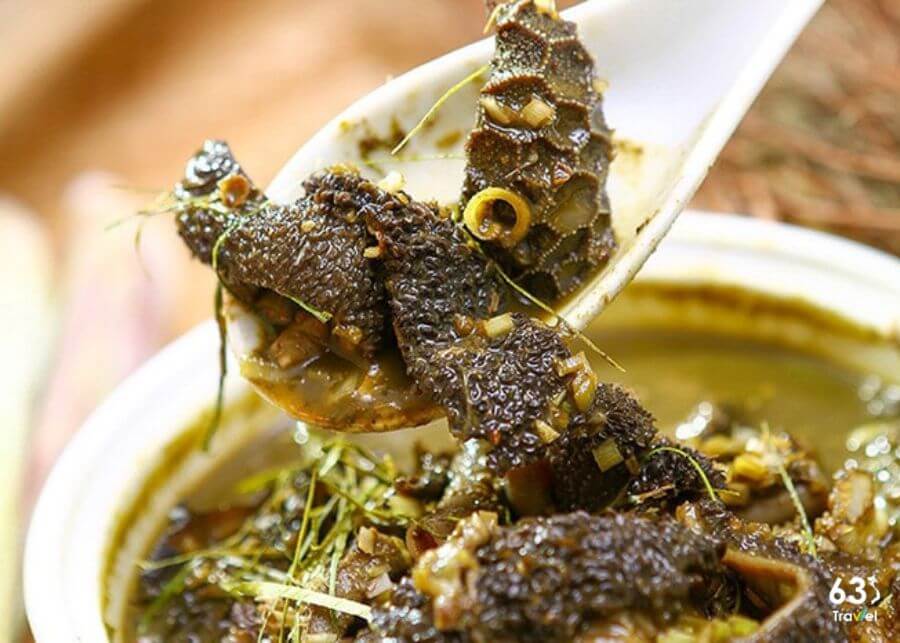
Nam Pia - Delicious dish in Son La
Although originating from traditional Thai food,Nam Pia is not simply a dish but also carries the quintessence of Northwest culinary culture. The flavor of this dish is special with a slightly bitter taste at first,then gradually changes to a sweet,fatty,fragrant taste of mountain and forest spices.
For those who love new culinary experiences,Nam Pia is a worthwhile challenge. However,for those who taste it for the first time,the dish can be a bit intimidating. However,just enjoying it once,you will feel the uniqueness and sophistication of Son La specialties,worthy of keeping in your journey to discover Northwest cuisine.
Occipital cross
Cham Xom is a Son La specialty,a unique traditional Thai spice,made from chili,garlic,mac Khen and typical herbs. With its spicy,fragrant flavor,cham diagonal is not only the perfect dipping dish for grilled meat,grilled fish or boiled vegetables but also the "soul" that highlights the rich flavors of Northwest cuisine. This is a meaningful gift,full of local essence,for you to give to your loved ones after each trip.
Mac Khen
Mac Khen is known as the "wild pepper" of Son La,and is an indispensable spice in Northwest cuisine. With a passionate aroma and mild spicy taste,Mac Khen is often used to marinate meat,fish or make dipping sauce,creating an unforgettable unique flavor.
In particular,when used to marinate grilled dishes such as pork,buffalo meat... Mac Khen highlights the richness and appeal. This is not only a spice,but also a meaningful gift imbued with Son La culture.
Buffalo meat is kept in the kitchen
Kitchen buffalo meat is one of Son La's famous gift-giving specialties,imbued with the flavor of the Northwest highlands. Made from fresh buffalo meat,this dish goes through a careful marinating process with typical spices such as mac Khen,lemongrass,chili,and then smoked on a wood stove.
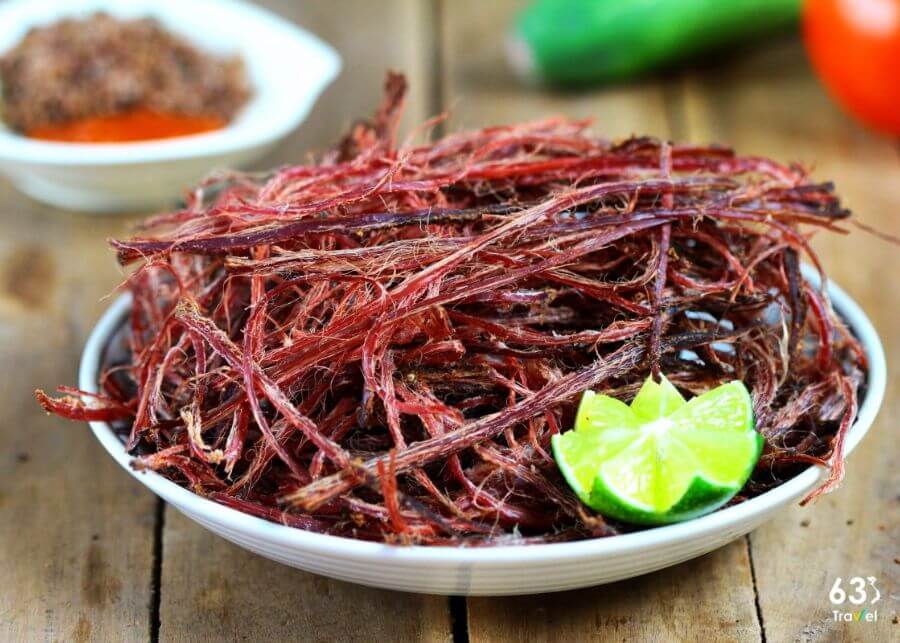
Kitchen buffalo meat - Delicious dish to try when coming to Son La
The finished product has a rich taste,seductive aroma and natural sweetness. Not only is it an attractive dish,buffalo meat is also a meaningful gift,expressing the sophistication and rich identity of Son La.
<< Read more: Top tourist attractions in Son La that are beautiful - attractive to tourists
Moc Chau green tea
Moc Chau green tea,a famous specialty of the Northwest Highlands,is not only a drink but also a cultural symbol and pride of the people here. Grown on vast tea hills at ideal altitudes,Moc Chau green tea brings a rich,refreshing flavor and unforgettable characteristics. The ancient Shan Tuyet tea variety,with tea leaves covered with fine white hairs,is meticulously processed,preserving the natural flavor.
Each cup of Moc Chau green tea is the crystallization of soil,climate and the ingenuity of the tea maker. From the slightly bitter taste at first to the sweet aftertaste,green tea here brings a unique experience to those who enjoy it. Not only a specialty,Moc Chau green tea also becomes a meaningful gift,expressing the sophistication,connection and rustic sentiment of Son La land.
Son La cat apple
Son La cat apple is a Son La specialty fruit,bringing with it the unique flavor of the Northwest mountains and forests. The small apple,smooth yellow-green skin and gentle aroma captivates anyone who has ever tasted it. The taste of cat apple is a harmonious combination of light sweetness,sourness and a bit of characteristic astringency,bringing an unforgettable experience to the taste buds.
Grown on high mountainsides and naturally cared for,cat apples are not only safe for health but also rich in nutritional value. This is not only a favorite fruit of indigenous people but also becomes a meaningful gift,bringing the flavor of the highlands to convey affection to friends and relatives.
Yen Chau sticky banana
Yen Chau sticky bananas are a famous Son La specialty,and have become a favorite gift of tourists coming to this land. Made from ripe yellow bananas,Yen Chau banana products are processed by pressing them thinly and then drying or baking,bringing a characteristic sweet,fragrant flavor.
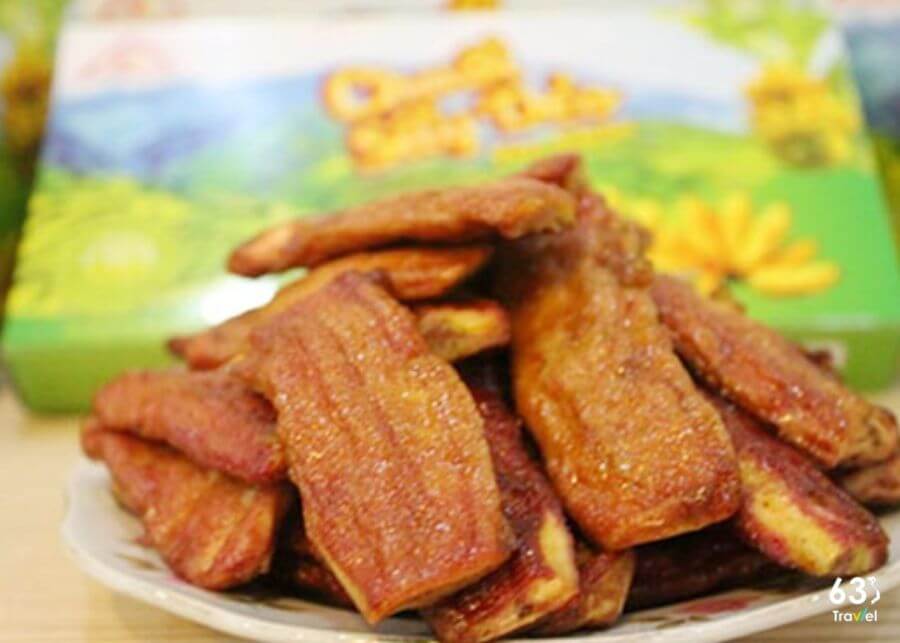
Yen Chau sticky banana - Son La specialty bought as a gift
Each piece of banana is both soft and chewy,creating an enjoyable feeling when enjoying. With meticulous processing and natural ingredients,Yen Chau bananas are not only delicious but also very nutritious.
This is an ideal snack for those who love simplicity but rich mountain flavors. This banana dish not only attracts diners from the first try but also makes them remember it forever,becoming a specialty not to be missed when coming to Son La.
Wild black turmeric
When asked what specialties Son La has this season,one of the outstanding specialties is wild black turmeric,also known as purple turmeric,dark turmeric. This is a precious tuber,not only famous for its excellent medicinal effects but also a nutritious gift that tourists often buy as gifts.
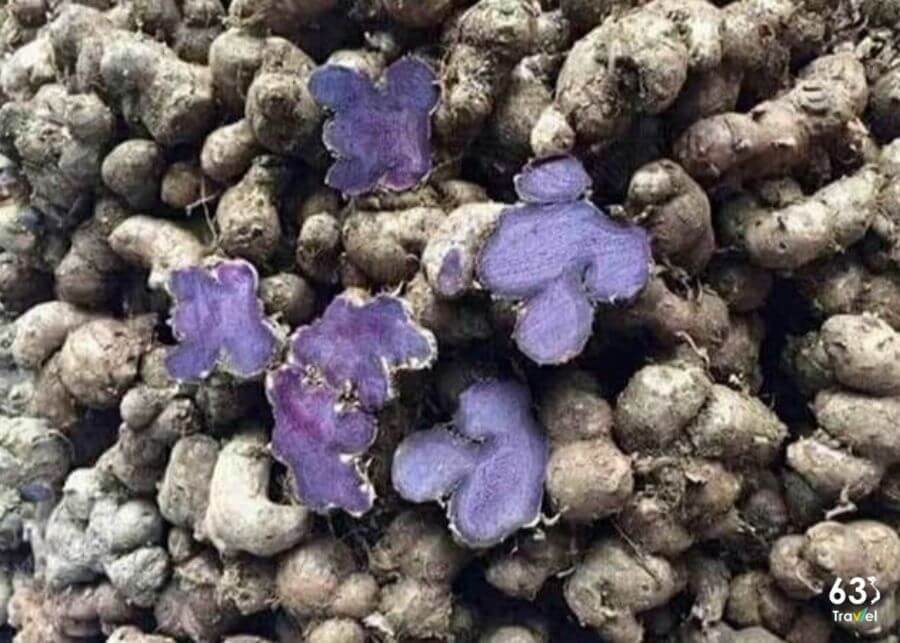
Wild black turmeric - Unique specialty in Son La
Black turmeric from Son La forest,according to traditional medicine,has a very good effect in treating digestive diseases such as stomach pain,flatulence,indigestion,or supporting the treatment of menstrual problems such as impotence. Menstruation,irregular menstruation,and many blood clots. In addition to its great medicinal uses,Son La black turmeric also has a unique flavor and is easy to use in food preparation or as a spice.
Taro
Son La taro is one of the outstanding specialties of Moc Chau. Taro tubers have yellow flesh like turmeric,and when processed,they bring a special sweet,fatty and aromatic flavor. The potato taste is soft and smooth but not too greasy,creating an unforgettable and attractive dish.
Taro is often processed by Moc Chau people into dishes such as stir-fried taro,boiled taro or soup. Each way brings wonderful culinary experiences. This is definitely an interesting gift that you can find and buy at specialty markets or supermarkets in Moc Chau to bring home to enjoy or as gifts for relatives.
Moc Chau corn wine and rice wine
Moc Chau corn wine and rice wine are two outstanding specialties,bearing the cultural imprint of the people here. Moc Sa corn wine is made from simmered corn,brewed with leaf yeast and steamed,creating a wine with a sweet,fragrant taste,captivating those who have once enjoyed it.
As for rice wine,a specialty of Hang Chu region,it is made from the best upland rice,incubated with rice germ with leaf yeast,then boiled and cooked for about 20 days,bringing a rich,warm flavor. Both types of wine have meticulous processing processes,demonstrating the ingenuity and long-standing traditions of ethnic minorities in Moc Chau. This is a meaningful and unique gift that visitors can bring home as gifts for relatives and friends.
Chiang Mai Duck
Chiang Mai duck is a famous specialty of Son La,attracting diners not only because of its unique flavor but also because of the meticulousness in its preparation. The duck meat is carefully selected,then marinated overnight with natural spices such as garlic,chili,ginger,onion and lemon leaves to create a delicate aroma.
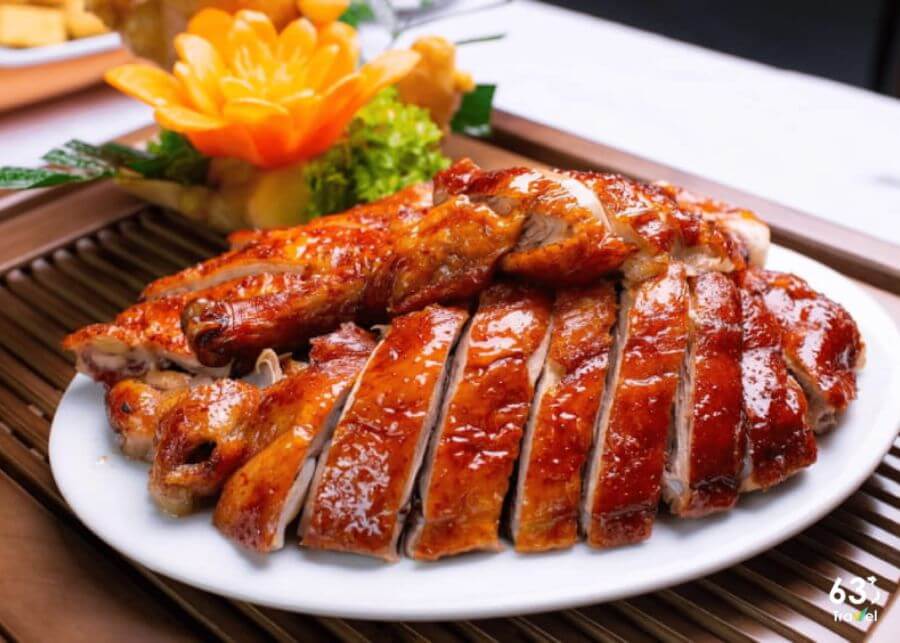
Chiang Mai Duck - Delicious dish in Son La
After this duck dish is grilled,the skin is golden brown,but the inside is still soft and delicious. When enjoying,Chiang Mai Duck is often eaten with raw vegetables,cucumber,and spices such as lemon salt and chili sauce,creating a harmonious combination of spicy,sweet and sour flavors. This is a dish not to be missed when coming to Son La,and is an ideal choice to bring home as a gift for relatives.
Son La pickled meat
Son La pickled meat is a typical dish,indispensable in the culinary culture of the people here. This dish is rich in flavor and prepared with great meticulousness. The meat is carefully selected,usually lean back meat,pork belly or tenderloin,then marinated with salt,garlic,chili,dried onions,lime leaves and some special spices such as chili powder,sticky rice wine,road.
The marinating process lasts from 2 to 3 weeks,helping the meat absorb the spices,creating a dish with a beautiful pink color,soft meat and a fragrant,characteristic sour taste. Pickled meat is often used during holidays,Tet or as gifts for friends and relatives,bringing an interesting taste experience and reflecting the beauty of Son La culinary culture.
Thang Co Moc Chau
Moc Chau Thang Co is a traditional specialty dish of the Northwest highlands,rich in flavor,rustic but also full of sophistication. This dish is mainly made from horse meat and offal,creating a special sweet and fatty taste.
What makes Thang Co Moc Chau different is the traditional recipe of the H'Mong ethnic people. With the use of unique spices such as Mac Khen,cardamom,bitter leaves and Vietnamese coriander,combined with delicate cooking methods.
To prepare,horse meat and internal organs are cleaned,marinated with spices and then cooked in a large pan over a charcoal fire,simmering for many hours until all ingredients blend together,creating a delicious dish. When enjoying,people will scoop all the meat,skin,and internal organs into a bowl,add chopped bitter leaves and dip with a special dipping sauce mixed with roasted salt,roasted garlic,chili pepper and a little Moc Chau corn wine. The flavor of this dish blends between greasy,fragrant and a little spicy,bringing an unforgettable culinary experience to anyone who enjoys it once.
Buffalo skin salad
Son La buffalo skin salad is a unique specialty dish,associated with the culinary identity of the Northwest mountainous ethnic groups. This dish not only impresses with its delicate combination of ingredients but also brings a new and attractive culinary experience. Fresh and delicious buffalo skin,sliced thinly and mixed well with green onions,coriander,laksa leaves,purple onions,garlic,chili and especially a little shrimp paste or shrimp paste,creates a rich,natural flavor. unforgettable.
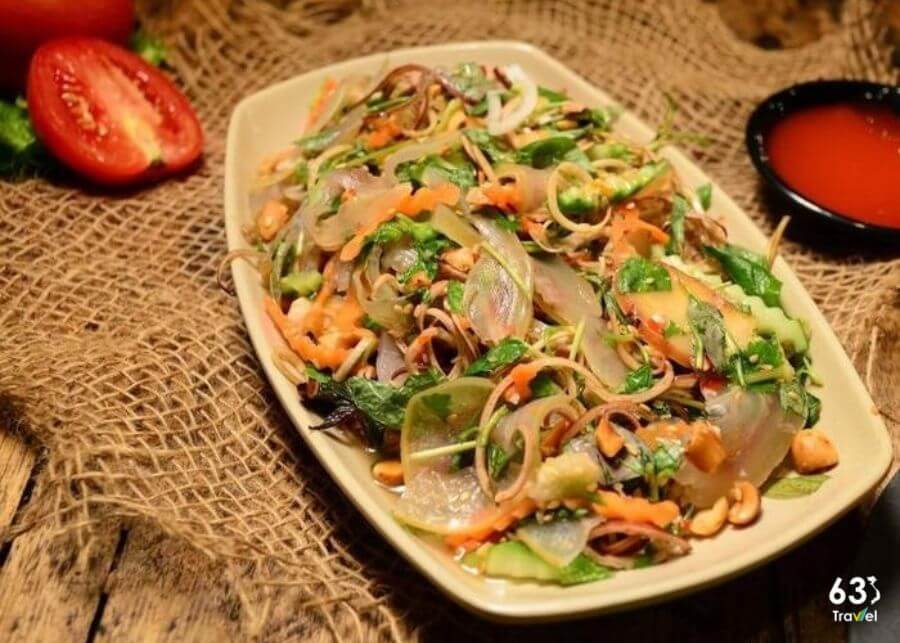
Return to Son La to try buffalo skin salad - a specialty "chew long and remember well"
The special thing about buffalo skin salad is the blend between the crispiness of the buffalo skin and the mildly sour and spicy taste from the spices. This dish is often eaten with thin rice paper and dipped in fish sauce,bringing a perfect combination of sour,spicy,salty and sweet,captivating all diners. With its unique preparation and rich flavor,buffalo skin salad is an indispensable dish when tourists visit Son La,contributing to enriching the culinary identity of this land.
<< Learn more: List of 16+ historical relics in sacred and long-standing Son La
Mac velvet porridge
Mac velvet porridge is a unique specialty of Son La,not only outstanding with its delicious flavor but also bringing many health benefits. Velveteen is a nutrient-rich fruit,harvested from the wild,containing many vitamins,minerals and fiber that nourish the body,improve resistance and help maintain youthfulness. After harvesting,the macadamia nuts are carefully prepared and steamed to retain their natural flavor.
When cooking porridge,mac velvet is combined with fragrant white sticky rice,simmered over low heat until the porridge is soft and smooth. This porridge dish has the sweet,cool taste of velvet,combined with the elasticity and aroma of sticky rice,creating a dish that is not only easy to eat but also very nutritious.
Mac velvet porridge is often enjoyed in the early mornings or on occasions when health recovery is needed,bringing a warm and pleasant feeling. This is a typical dish,reflecting the culinary and folk medicine quintessence of the people of Son La.
Ca chao
Veal stir-fry is a famous specialty of Son La,imbued with the flavor of the Northwest mountains and forests. To prepare this dish,the maker must choose fresh pieces of veal,cut them into evenly thin slices to easily absorb the spices.
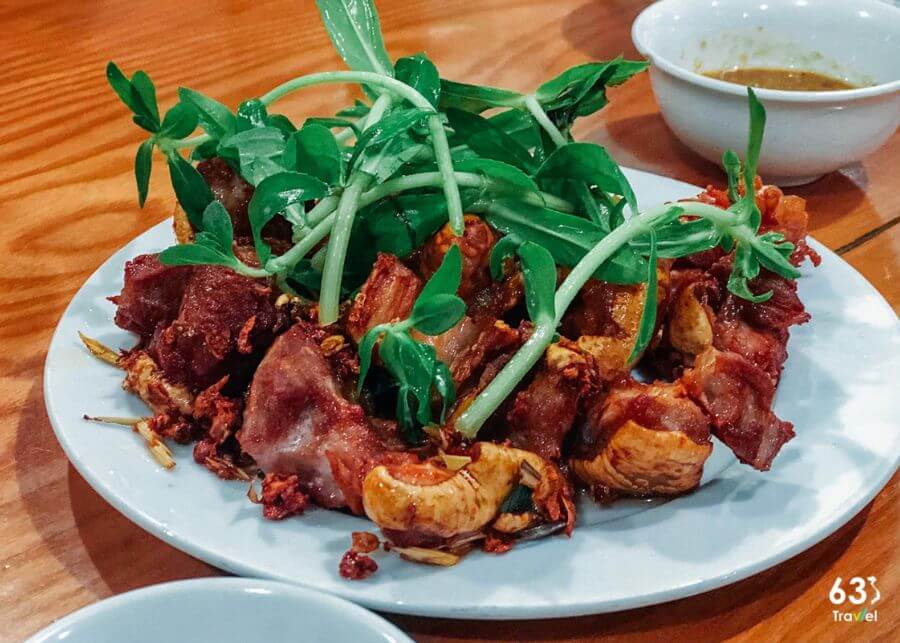
Veal Chao - An irresistibly delicious specialty famous in Son La
Veal,after being marinated with spices such as garlic,onions,chili,pepper and some other spices,depending on the taste of each region,will become soft and rich in flavor. The marinating process not only helps the meat absorb spices but also preserves the freshness and purity of the veal.
Veal stir fry is often grilled on a charcoal stove or charcoal fire,helping the meat cook evenly and keep it crispy on the outside and soft and sweet on the inside. The aroma of grilled veal emanates seductively,attracting diners right from the moment the dish is still on the stove. When enjoyed,fried veal not only brings a rich flavor but also demonstrates the ingenuity and sophistication of Son La people in preparing dishes from natural ingredients,creating a unique culinary experience. and unforgettable.
Above are the specialties in Son La that you must try once when traveling and buy as gifts,imbued with the flavor of the mountains and unique culture of this land. Don't forget to enjoy these delicious dishes on your journey to fully experience the beauty of Son La cuisine. Prepare carefully and bring home special and meaningful gifts for friends and relatives. Wishing you a wonderful trip and many memorable experiences!
Son La 3646 view
Update day : 20/12/2024
In addition to the name Dai Yem, this waterfall is also called "Nang waterfall" or "Ban Vat waterfall". The waterfall originates from two streams of Bo Co Lam and Bo Ta Chau, located at the confluence of Vat stream and Bo Sap stream, in Muong Sang commune, Moc Chau district. Legend has it that more than 700 years ago, there was a couple who loved each other dearly. But because of the war, both had to separate. The boy went to war, and the girl went to the waterfall every day to wait for her lover to return. One day, it rained and stormed, the water flooded the entire waterfall. The girl was swept away, leaving only the token of love, an embroidered scarf, scattered near the waterfall. The villagers mourned so they named the waterfall "Dai Yem", which in ancient Thai means "Love Thread". Because of this touching legend, the waterfall has become a place to "prove love" and an ideal destination for many couples. Currently, the waterfall is being preserved and managed by Dai Yem Waterfall Tourist Area. Like a girl in the age of love, Dai Yem waterfall is sometimes gentle and peaceful but also sometimes fierce and passionate. To fully feel the wild beauty mixed with a bit of dreaminess of the waterfall, you should come here during the pouring water season. The period from April to September is the best time to see the falls. At this time, the stream flows rapidly, the amount of water pouring in is huge, creating a white, mesmerizing curtain, making viewers overwhelmed and excited. But if you want to see something gentler and quieter, you can also visit the waterfall in the dry season. At that time, the waterfall will become gentle and full of dreams. The sound of the gurgling stream mixed with the chirping of birds from the deep forest, all blend together, creating a poetic scene. But if you want to see something gentler and quieter, you can also visit the waterfall in the dry season. At that time, the waterfall will become gentle and full of dreams. The sound of the gurgling stream mixed with the chirping of birds from the deep forest, all blend together, creating a poetic scene. The first experience that any tourist cannot miss is admiring the majestic beauty of Dai Yem waterfall. The waterfall is more than 100m high, divided into two distinct branches: the upper waterfall is about 4,000 m2 wide with 9 floors symbolizing 9 levels of love, while the lower waterfall is smaller (area of about 300 m2) and includes 3 floor. The two clusters of waterfalls are about 200m apart, flowing day and night. From a distance, they look like a soft peach band winding around the cliff. With its poetic and magical beauty, this waterfall has become a place to visit, picnic, check in and take photos for many tourists, especially young people.
Son La
From January to December
5451 lượt xem
Tien Phong Lake in Son La is a typical place of wild and majestic beauty, but extremely romantic in the Northwest mountains and forests. Visiting this land, visitors will admire the charming feng shui and enjoy the fresh air of nature, and have many interesting experiences when yachting on the lake. Located in the middle of the vast steppe, Tien Phong Lake has thousands of winds and warm sunshine, captivating many tourists. Tien Phong Lake in Son La is located in Muong Bom commune, Mai Son district. The place is located right next to National Highway 6, 23km from Son La town, 7km from Hat Lot town and 2km from Na San airport. This is a prime location surrounded by majestic mountains. It is a place surrounded by beautiful nature - in the middle of the immense steppe. To the East and North are two majestic mountain ranges, one after another. To the East is the Na San plateau full of fruits and thousands of green tea hills. All have created a charming landscape, attractive nature, bringing moments of relaxation and peace, holding the traveler's feet. The scenery of Tien Phong Lake is created from Tien Phong dam made of earth and solidified by solid concrete panels. Tien Phong Dam is 23m high, 120m2 wide and 120m long. Coming here, visitors can witness with their own eyes the beautiful natural scenery with a stretching blue color. The vast lake surface is jade green, in the distance there are deep green tropical forests and deep clouds and sky. Nature guides us, people do not want to leave the majestic landscape of Tien Phong. Cruising is an attractive experience for tourists when visiting Tien Phong Lake in Son La. There's nothing more wonderful than floating on the water and taking in the wonderful view of nature. You can choose to row a manual boat, a pedal boat or a motor boat depending on your preference. Many tourists also choose to fish to preserve the beautiful nature. Just do it the way you like, immerse yourself in nature to feel the slow passage of time, preserving the most wonderful emotions. From a distance, the floating island looks like a turtle's shell floating in the middle of the lake. The landscape here is always green and fresh from the young grass and the wind. The wind brings cool and refreshing steam to the small island. Exploring the floating island, visitors will be immersed in the fresh nature here, enjoying the freshest and most peaceful air of their lives.
Son La
From January to December
5559 lượt xem
Possessing an impressive height above sea level of 2,000 m, the mountain peak is located in the Vietnam - Laos border area and has received the love of many tourists in recent years. After arriving at the center of Moc Chau district, you need to travel another 40 km to reach the foot of the mountain. In addition to the name Pha Luong peak, visitors can also use the name Bo Lung to talk about this tourist destination. When you come here, you will experience the feeling of conquering the mountain peak with impressive heights. In particular, it is the feeling of seeing the majestic and wild scenery from above that is not available everywhere. For those who love to explore and are passionate about adventure sports, this will be a great destination. You can also enjoy the fresh, cool atmosphere of the Northern highlands and relax after the stress and fatigue of life here. For young people, this is an ideal check-in point and great "cloud hunting" in the early morning. Featuring the climate of the North with four distinctly changing seasons, visitors can reach Pha Luong peak at any time of the year. Because this place at each time will bring its own unique beauty and impression to tourists. However, because the road to the top of the mountain is up to 2000m high and difficult, visitors should choose a travel time from March to April. This is the time with warm sunshine and no rain, convenient for climbing. The mountain is safer as well as helps the sightseeing process. One of the famous check-in points when conquering Pha Luong peak is the uniquely shaped rock outcrop. The breadth of space and scenery, along with the rocky outcrop that juts out, make your photo even more impressive. Visitors do not need to worry because the stones are quite large and thick. Be careful when checking in in the rain because they are easily slippery. In addition to experiencing the scenery and atmosphere at the top of the mountain, visitors also have the opportunity to discover more about the typical Lao market. You can find handicraft products, specialty dishes in Moc Chau, dried meat,... as gifts for relatives or friends after the trip. Although it is an attractive tourist destination and brings wild and impressive beauty to tourists. But Pha Luong peak is quite difficult to conquer, so in addition to experience, you also need to know the following notes: With an altitude of 2000m, when you reach the top of the mountain you will see the temperature drop quickly. Especially, if you come in the winter, the temperature is lower, so you need to bring warm clothes, towels, wool hats, gloves, etc. To avoid sudden changes in temperature that affect your body. During climbing, you should use specialized shoes for climbing. Do not wear flat shoes or sandals because they can cause slipping and danger during movement. Visitors should carefully consider their health and mobility before deciding to climb Mount Pha Luong. People with cardiovascular diseases should not move to the mountains. Before conquering the mountain peak, you should have a light snack and drink water to give yourself more energy. Absolutely do not arbitrarily throw trash indiscriminately while moving or visiting the mountain top. Always bring identification documents to present for check-in procedures at the border station.
Son La
From March to April
5829 lượt xem
In the heart of the city, there is a hill named Khau Ca lying beside the Nam La stream. This place also preserves historical evidence of Son La Prison - evidence of a historical period of revolutionary struggle and the spirit of injustice. The remains of resilient communists who were imprisoned by the French colonialists, and the Son La museum, which displays many precious artifacts, introducing the historical and cultural traditions of a community of 12 ethnic groups united together. together to build Son La into a rich province of Vietnam. Son La Prison was built by the French colonialists in 1908 with an initial area of 500 m2. The prison is built quite solidly: the walls are built of stone and brick, the roof is covered with corrugated iron, there is no ceiling, the beds for prisoners are also built of stone, the surface is cemented, the outside edge is attached with a system of vertical leg shackles. along the length of the floor. In each cell there is a floating toilet built higher than the floor, without a lid, without flushing water, and not cleaned regularly. With such a design, in the summer, the Lao wind of the Northwest region causes scorching heat, the frost creates cold, bone-chilling cold in the winter, combined with the polluted environment in the area. Each cell has caused diseases to arise and spread very quickly among prisoners. In 1930, the Communist Party of Vietnam was born and led the people to fight against the brutal regime of feudal colonialism. The struggle movement surprised the enemy, who frantically sought every way to suppress and arrest patriotic Vietnamese people in an attempt to quell the revolutionary movement. On the other hand, strengthen the construction and expansion of the prison system throughout the country, paying special attention to Son La prison. In 1940, Son La Prison was expanded to add a large prison to hold more prisoners and send a number of female prisoners to Son La, but that plot failed to materialize. Thus, through 3 times of construction and expansion, Son La prison has a total area of: 2,170m2. The French colonialists turned this place into a living hell to imprison, deport and destroy the will of the Communists to fight. With an extremely harsh prison regime and extremely cruel torture methods, the enemy thought they could destroy the spirit and body of the revolutionary soldiers, but this place became a revolutionary school. network, train the will and supplement the Party and the revolution with loyal communist soldiers and party members, most notably the role of comrade To Hieu and many other loyal comrades. After being devastated twice by the enemy's bombs, the old relics are now dilapidated, remaining almost nothing more than a pile of destroyed bricks, and the ruined prison walls are a testament to the brutal crimes of the enemy. What remains intact is the To Hieu peach tree, a symbol associated with the name of the steadfast Party Secretary of the prison, which still blooms brilliantly when spring comes... In 1952, when the French colonialists withdrew from Son La, they bombed to erase traces of their crimes. The second time in 1965, the American imperialists raided Son La Town and destroyed part of the prison. In 1980, Son La Museum carried out the first restoration: Leveling bomb craters, rebuilding some surrounding fence sections; The second time, in 1994, restored the two watchtowers, the kitchen, the large prison, reinforced the underground bunker, and built the walls of the cells according to the traces of the old foundations. In 1994, Son La Museum intended to restore the entire relic site to its original form, but could not find complete records, so there was not enough scientific basis to restore the entire site. Just build the walls a little higher so visitors can visualize the structure of the Son La prison complex. Every year, the historical site of Son La prison welcomes hundreds of thousands of tourists to visit, research, study... Surely, at some point, tourists come to Son La, return to the mountains and forests. Northwest to experience and reminisce about the war that took place more than a century ago; With the skillful leadership of the party, the passionate patriotic spirit willing to sacrifice for national independence, the strong solidarity between peoples... We have left behind a peaceful country for today's posterity.
Son La
From January to December
5590 lượt xem
With an area of 6,915 square meters, Bat Cave contains an underground water source that never dries up. The name Bat Cave originates from the fact that in the past, there were large colonies of bats living and nesting here, but now they have left elsewhere. However, the name Bat Cave is still called by people here to this day as a familiar name from a long time ago. Above the ceiling of the cave are high stone arches hanging down to form magical shimmering stalactites. These stalactites form many interesting shapes such as fairies, fairies, animals... All create a scene that is both sparkling and majestic. This is a place that when traveling to Moc Chau you should not miss! Legend has it that once upon a time, there was a sacred dragon who, when flying over this land, saw the majestic mountains and cool climate, so he humbled himself and hid in Bat Cave and resided here. That's why this mountain range has many mysterious colors such as: white in the morning, blue at noon, then pink in the afternoon, and finally purple at sunset. People here often tell each other that it is because the dragon's body is surrounding the mountain. Later, when the dragon died, it released 7 pearls to repay the favor. The 7 pearls are the 7 mountains that later created Bat Cave. Thanks to the legendary stories that have been passed down from generation to generation, this place becomes even more attractive and makes many curious tourists want to come here to verify. From the moment you enter from the cave entrance, the light shining into the cave will make you feel like you are lost in a fairyland with different dark and light shades. Visitors will admire the beauty of the limestone stalactites hanging down, creating an amazing natural picture. Furthermore, these rocks also have many different shapes, making them interesting for visitors. The most special is the stone block shaped like a man and woman in love in the shallow lake in the middle of the cave, a highlight that makes everyone admire. In the cave, in addition to the shapes created from limestone blocks, there are also many banyan trees whose roots form shapes on the ground such as elephants, tigers... Another special thing about Son Moc Huong Cave is that the middle of the cave is arched higher than other places in the cave, with a stone curtain at the entrance. This is called the "princess" chamber, which is also an attraction in this place. This. Bat Cave is both a place to visit and a place to explore with forests and trees growing around, so visitors need to pay attention to the following things: Because the cave is located in a dense forest, visitors should wear comfortable and covered clothes to both climb the mountain and avoid being bitten by insects or mosquitoes. You should also bring mosquito spray to ensure safety. , especially with children. When visiting Son Moc Huong Cave, parents need to pay attention to their children's health when climbing the mountain and visiting the cave, then provide timely solutions if the child is too tired or too hyperactive to run around. toss.
Son La
From January to December
6664 lượt xem
Thuan Chau Flag Tower historical site is located in Pan village, Chieng Ly commune, Thuan Chau district. This place marks a historic event on May 7, 1959, when President Ho Chi Minh together with the Party and Government leadership visited the Northwest. During the resistance war against the French and after peace was restored in the North, despite being busy with thousands of national affairs, Uncle Ho, the beloved Father of the nation, always cared about the people of the Northwest ethnic groups. Responding to Uncle Ho's trust, the people of the Northwest ethnic groups were courageous in fighting, enthusiastically emulating productive labor and wished to welcome Uncle Ho to visit and report to him on his achievements. On May 7, 1959, the wishes of the people of the Northwest peoples came true. The square of the capital of the Thai autonomous region, Meo, was resplendent with flags, flowers, banners and slogans and more than 10,000 people representing 430,000 people from the Northwest ethnic groups happily welcomed Uncle Ho leading the Party and Government delegation. cover the visit. With an extremely simple, intimate and close gesture, Uncle Ho recognized and praised the sacrifices and enormous contributions of the people of the Northwest ethnic groups in the resistance war against the French colonialists and in restoring the economy. economy after the war. On behalf of the Government, he presented the people of the Northwest ethnic groups with the first-class Labor Medal. He advised: We must enthusiastically compete for economic and social development, strengthen economic sectors, apply science and technology to production, develop education and healthcare networks, and strengthen national security. room. More than 40 years have passed, and his advice has been persistently strived to be implemented by the Party Committee, government and people of Son La ethnic groups, and has been making great changes in the Western region of the country. big. Today, the Thuan Chau flag tower historical relic is located right on the campus of Thuan Chau district stadium. Source: Son La province electronic information portal
Son La 6719 lượt xem
Son La Prison was built by the French colonialists in 1908, next to Nam La stream on top of Khau Ca hill, now in To Hieu ward, Son La city, Son La province. This place held 1,007 communist prisoners, was a revolutionary school, and where the "red seeds" of the Vietnamese revolution were nurtured. Son La Prison was built by the French colonialists in 1908 with an initial area of 500 m2, mainly to imprison common criminals. In 1930, as the Vietnamese revolution's struggle for national independence increased, the French colonialists expanded Son La Prison by 1,500 m2 and began to detain political prisoners. In 1940, the French colonialists built a prison camp with an area of 170 square meters with the intention of holding female prisoners, but this plot was not carried out. Thus, through 3 times of construction and expansion, Son La Prison has a total area of 2,170 m2. In particular, during the process of expanding the prison, the French colonialists also built a series of underground cells 3 meters deep underground, hidden by the kitchen area above. The underground cell system includes 5 individual cells and 2 collective cells, including 1 dark cell. Son La Prison is solidly built, with walls made of stone and brick, and a roof of corrugated iron. The beds for prisoners are built of stone, have a cement surface, and have a leg shackle system along the length of the floor on the outside. With such a design, the Laotian winds of the Northwest region with blazing heat in the summer and cold frosts in the winter have caused diseases to arise and spread quickly. Son La prison is likened to "an open coffin, just waiting for the prisoner to die and bury him". From 1930 to 1945, the French colonialists exiled to Son La Prison 14 groups of political prisoners with a total of 1,013 prisoners, including many comrades who were members of the Central Committee, Party Committee, City Party Committee and many others. core Party officials. Faced with the crimes of the enemy, more than ever, the spirit of the communists shone and lit the fire of revolutionary struggle throughout the Northwest mountains and forests, greatly contributing to the success of the General War. August Uprising in 1945. This place has become a great revolutionary school, training and fostering for the Party and the Vietnamese revolution outstanding and typical Communist soldiers such as: To Hieu, Le Duan, Truong Chinh, Nguyen Luong Bang, Van Tien Dung, Le Duc Tho, Nguyen Van Tran, Le Thanh Nghi, Tran Quoc Hoang and other faithful comrades. With peace restored, Son La Provincial Museum has renovated and embellished the Prison relic three times in 1980, 1994, 2009 - 2010. Son La Prison historical relic also has 2 points: Ban Heo banyan tree, the contact point between Son La Prison Cell and the Party Central Committee and Son La Prison Martyrs Cemetery (Guava Root Cemetery) is The resting place of more than 60 heroes and martyrs who sacrificed their lives at Son La Prison. The historical site of Son La Prison has become a red address in the work of educating revolutionary traditions for generations of ethnic groups in Son La and the people of the whole country. Son La Prison was ranked national in 1962 and a special national historical site on December 31, 2014. Son La Prison Relics has become a school, a center of revolutionary traditional education for generations of Vietnamese people, especially the younger generation. Source: Son La Province Electronic Information Portal
Son La 6605 lượt xem
In the early twentieth century, the French colonialists established their governing apparatus in the Northwest region. They built Son La Prison to imprison, exile, and destroy the will to fight of revolutionary soldiers and patriotic Vietnamese people. In December 1939, political prisoners at the prison held a secret meeting and decided to establish a provisional cell. The cell chose the Heo banyan tree as a secret contact point with the revolutionary base outside the prison and with the Party Central Committee. In 1942 - 1943, the revolutionary situation in the country and the world was very volatile, the Party Central Committee directed the Yen Bai and Phu Tho base areas to establish a contact line with the Son La prison cell. Every day, political prisoners in Son La Prison had to go to the banyan tree area to get firewood, so the prisoners set up a secret mailbox to contact and assess the enemy situation, in order to organize an escape. According to the planned plan, in January 1943, Comrades at the Central Agency arranged to meet with comrades in Son La Prison Party Cell at Ban Heo banyan tree. Agree on the prison escape plan. With the careful preparation of prisoners from inside the prison to comrades and soldiers outside the prison, on August 3, 1943, the Cell successfully organized an escape for elite prisoners. returned to the Party Central Committee to continue revolutionary activities. Thus, during the period of struggle against the invading French colonialists, along with other communication locations, the Heo banyan tree was the place where the secret mailbox was located, and the meeting and communication place between communist soldiers of the Communist Party of Vietnam. The prison cell and the Central leadership - have really played an important role, contributing to creating a solid information network, covering the enemy's dense spy network, serving development. of the revolution and contributed greatly to the victory of the movement to gain power in Son La in particular and the country in general. The Heo banyan tree is now a revolutionary historical relic in the special national relic complex of Son La Prison, managed by the Provincial Museum. Every year, the monument welcomes hundreds of thousands of visitors to visit, learn and research. Even though it has gone through many ups and downs of history, the banyan tree is still there as a testament to a historical period of revolution in the twentieth century. Source: Son La Provincial Museum
Son La 6492 lượt xem
Que Lam Ngu Che stele historical relic belongs to group 3, Chieng Le ward, Son La city. This place demonstrates the historical period of the talented and great strategist Le Thai Tong and his soldiers conquering rebels in the western border region of the country, keeping peace for the country. The relic was ranked at the National level by the Ministry of Culture and Information on February 5, 1994. King Le Thai Tong, whose name is Nguyen Long, is the second son of King Le Thai To (Le Loi) and Queen Mother Pham Thi Ngoc Tran, a native of Quan Lai, Loi Duong district (now Tho Xuan - Thanh Hoa). ). Since ascending the throne, King Le Thai Tong has paid great attention to the Northwest region, the land of the country. To consolidate and ensure national unity, like King Le Thai To and other kings, during the 9 years of reigning the country, King Le Thai Tong twice commanded soldiers to go to the Northwest to suppress traitors. inverse. In March of the year Canh Than (1440), the king for the first time personally and with his soldiers went to the Western town to fight a rebel army named Thuong Nghiem in Chau Muong Muoi (now Thuan Chau district, Son La province). Wherever the king went, he was supported by the people, so the royal army quickly crushed the rebels. On the way back, the king and his soldiers stopped at Dong La (Tham Bao Ke), a natural rock cave in Muong La province. The king saw that this place had beautiful scenery, favorable geography, profound meaning and a peaceful soul. The king had his soldiers carve a poem and preface on the cliff at the entrance of Dong La. The poem, Guilin Ngu Che, has the following meaning: "The chief of Thuan Chau, Thuong Nghiem, rebelled, was ungrateful, and led his troops to follow the Ai Lao people to rebel. Personally commanded six armies to conquer it. Thuong Nghiem used all his strength and offered an elephant to surrender. I felt sorry for him for kneeling and crawling without a weapon, not having the heart to cut him, so I forgave him, then brought the army back and left a poem. Exactly one year later, in March 1441, the king again sent troops to suppress the Nghiem Nghiem rebellion in Chau Muong Muoi. Everywhere he went, the people responded and helped him, so the royal army quickly captured General Ai Lao. Dao Mong, at the same time captured Thuong Nghiem's children Sinh Tuong and Dong Dong. The traitor Thuong Nghiem surrendered and accepted the crime, from now on the western border of the Fatherland has been at peace. To pay tribute to the merits of King Le Thai Tong and to make the Que Lam Ngu Che stele monument forever dignified and shine in the hearts of successive generations, meeting the spiritual and healthy religious needs of a large number of people. people, with the consent of the Ministry of Culture and Information, in September 2001 the Provincial Party Committee and People's Committee of Son La started construction of the temple of King Le Thai Tong in Son La town and was inaugurated on September 22. January 2003, named "Guilin Ling Tu". Source: Son La province electronic information portal
Son La 6409 lượt xem
Ta Vai Bridge, located in Ta Vai village, Chieng Hac commune, Yen Chau district, is a famous historical relic of the province. During the resistance war against the French colonialists, the bridge not only had a meaning for people's livelihood but was also a historical relic. Ta Vai village has a bridge with 46 fierce attacks and suffered 1,272 bombs from American aircraft to cut off the main artery of Highway 6. But the bridge still stands, ensuring smooth traffic. In 1965, the American enemy used air force and commandos to frantically sabotage the North in order to prevent the North from providing support to the Southern people. On June 20, 1965, American planes dropped 6 bombs on Khau Day village (Chieng Hac, Yen Chau) and 20 rockets on Ta Vai bridge. . Starting from here, American aircraft continuously bombarded Yen Chau, but due to good preparation of plans to deal with America's destructive war, Yen Chau entered the war without being surprised. At this time, Ta Vai bridge became a place of fierce fighting between us and the enemy. With the determination to ensure smooth traffic flow in all situations, determined to stay at the traffic center of Ta Vai bridge, the militia and self-defense force and armed force units have always stuck to the road and bridge to ensure traffic is clear. Here, from March to December 1966, we arranged the 14th Battalion of anti-aircraft artillery to protect the Ta Vai bridge, in which Company 3, consisting of two 37mm artillery batteries, was positioned in the area of Ban Tat hill. , adjacent to Tai Vai bridge, Company 2, consisting of four 37mm guns, was arranged in a continuous position to the west of Ta Vai bridge. In addition to the two main battlefields with 37 mm cannons, there is also a secondary battlefield consisting of a 12.7 mm company located in lower terrain also near Ta Vai bridge. To arrange such a battlefield, the people of Ta Vai village and the soldiers dug fortifications to build a road around the hillside to pull up artillery. Each 37 mm cannon required 200 people to pull it. To encourage morale and help soldiers fight, the people of Ta Vai village enthusiastically participated in the fighting and produced rice to contribute to the front lines. During those years, the people of Ta Vai, along with other villages in Chieng Hac commune, contributed nearly 9 tons of vegetables, 500kg of poultry, tons of food... In addition, the commune's performance team also went to the battlefield in uniform. army and militia service. Many times having to move the battlefield, the people and the soldiers used forest rope to braid to pull the artillery; used bamboo to make shacks for the soldiers and helped the soldiers dig over 3,000 meters of shelters on the battlefield with the determination to protect the transportation artery for the battlefield. The enemy destroyed bridges and roads, but the spirit of the army and people here was undeterred. Despite the roar of bombs and bullets, they still enthusiastically repaired the roads for vehicles to pass, with the emulation movement "Singing over the sound of bombs" and "Singing over the sound of bombs" and "Singing over the sound of bombs" The enemy broke it, I'll fix it. If the enemy destroys me, let me go." On December 8, 1966, the enemy organized 3 groups of planes to drop bombs on the hill where there was an anti-aircraft artillery battlefield and bombarded the Ta Vai bridge. At this time, 2 bridge spans were hit by bombs and fell into the stream and traffic on Route 6. was cut. Because the bridge was in a dangerous location, the stream was wide, the water was deep, and the enemy fought day and night, so it was very difficult to rebuild the bridge. Faced with that situation, the bridge protection unit decided to build a bypass and underground road to ensure traffic at all costs. The underground tunnel of Ta Vai bridge was built by soldiers and civilians about 1km downstream, but the enemy still discovered it and continued to bombard it. With courageous fighting spirit, the army and militia units have well secured traffic arteries. Promoting the tradition of tenacious fighting and the spirit of solidarity, the people of Ta Vai village with a boiling spirit of hatred for the invaders turned into revolutionary actions in combat and production, making an outstanding contribution to the achievements in defeating the US imperialist plot to expand the war. At the Ta Vai battlefield, the army and people of Yen Chau shot down 2 F105 planes and captured American enemy pilots with rifles, the lifeline of support for the South was always running smoothly, that victory quickly spread throughout the world. place, known throughout the country. Today, the war has receded into the past, the people of Ta Vai work hard in production and continue to contribute human and material resources to their homeland, where the Ta Vai bridge marks the crimes of American imperialism during the war. war of invasion in Vietnam. Talking about Ta Vai bridge is talking about the heroic, resilient fighting spirit and glorious fighting of Yen Chau's army and people. Source: Son La province electronic information portal
Son La 6312 lượt xem
House number 125 - Quarter 5 - Moc Son Ward
Hiệp hội du lịch Son La
Chỉ từ : 23.4 $
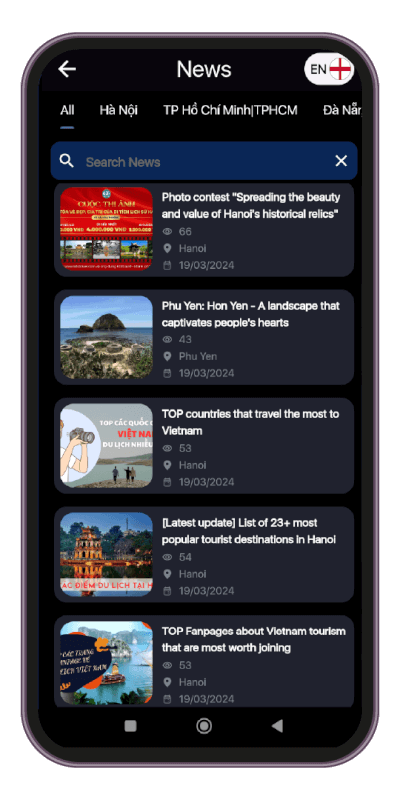

Download the Travelviet app to receive notifications about the latest travel news
